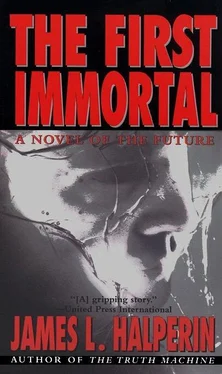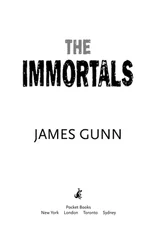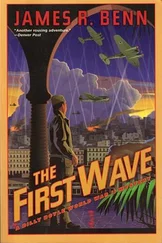The work on Wendy II began promptly at Six A.M., although most of us had been there since five-thirty. As for me, I’d been unable to sleep at all during the previous twenty-three hours. Today’s outcome would be critical, and there were simply too many unknowns. Notions of potential disasters had jolted my brain like dozens of tiny alarm clocks.
* * *
Even without cryoprotectants, freezing damage is subtle. Cells do not burst. Occasionally, however, their outer membranes may puncture from the expansion of water, which comprises nine-tenths of their volume. More often, just a tiny percentage of cells are damaged, usually when some molecules are misplaced, and many of these molecules return to their correct positions upon thawing. Indeed, countless living humans, some born as long ago as the late twentieth century, had once been frozen at liquid nitrogen temperature, as embryos.
But postembryonic mammals are delicate; even a slight disruption of the molecular structures in an infinitesimal percentage of its cells will render the entire organism nonviable. Freezing damage at liquid nitrogen temperature, while narrow in one sense, is vastly more extensive than a mammalian body can withstand or self-repair.
Until February 2064, no mammal had ever been deep-frozen and then successfully revived, and even now, nearly five months later, there was still no incontrovertible proof that the nongenetic memories of those creatures had survived intact.
Wendy had been vitrified, which minimized disruption damage but created a new problem: removing the glassy sap cross links holding the molecules in place. That would be the first task of the three trillion disassembler/assembler machines, nearly half a pound of them, deployed through Wendy’s vascular system.
Dr. Abel Dewar injected the D/A’s through a microscopic perforation in Wendy’s chest. The machines received no help from the frozen bloodstream, yet within seconds spread their way through the dog’s veins, arteries, and capillaries. The cryo-protectant removal was accomplished in 128 minutes.
The machines returned to their positions, guided by nearly a billion nanocomputers interspersed among them, each a thousand times larger than the D/A’s themselves. (The concoction now weighed eleven ounces.) This army of machines would require sixteen hours to effect repairs, and to thaw and revive Wendy. If nothing went wrong, which was unlikely.
The first fourteen hours saw no serious emergencies, as expected. Every living cell was static. Such is the beauty of cryonic suspension: It virtually halts every retrogressive biological effect of time’s passage. The thawing would be the difficult part.
We nine pioneers of nanoscience monitored progress like zealous sports fans; as if by watching intently enough, we might somehow affect the outcome. We sat transfixed, staring at our 3-D screens or hooked to VRs while the D/A s began the tedious process of cell repair, and replacement wherever aging had destroyed entire cells.
Despite her near perfect vitrification, Wendy’s DNA strands now averaged an error every 640,000 nucleotides, more than sufficient to wreak havoc. Nearly all of this was freezing damage that happened as they’d warmed her up, the remainder being from normal radiation that had occurred over Wendy’s life. But we believed nanomachines could repair it all, and much more efficiently than her body’s natural repair enzymes could ever hope to.
Using central computers, a perfect DNA map had been constructed during the first few seconds of the process. The D/A s had compared the DNA from eighty randomly selected cells. Even this was overkill. The odds of any identical error occurring in three or more strands out of five would have been virtually zero. But I figured comparing eighty strands was no more time-consuming than comparing five, so what the hell? The actual examination and repair of over two trillion tissue cells, however, would require considerably more time: fourteen monotonous, nerve-racking, and ultimately uneventful hours.
By ten P.M. the repairs were complete, and Wendy II now possessed all the cellular structures of youth; a three-year-old dog’s unimpaired enzymes, collagen, bone and muscle strength, and immune system. At that moment, she boasted the most perfect DNA of any canine adult on earth. Technically, her age was still nearly thirteen, so the “genetic clock” mechanism in her cells would likely kill her off within nine more years despite the repairs, unless a way to reverse the clock were discovered by then. But if everything went as planned, she would soon have the energy, strength, and resiliency she’d possessed ten years before. If there had been no mistakes. If only we could be sure…
At 10:27 P.M. the first warning signal beeped.
“What the heck is that?” Stephanie Van Winkle, Abel’s very attractive assistant, asked him.
“Damn! Of course,” the medico answered. “Soon as she started thawing, her body would’ve noticed the invaders, and now her immune system’s been activated. Never could’ve predicted such a violent reaction, though…”
“Jesus! It’s going nuts,” I blurted as I stared at the infrared 10 9x image on my 3-D visor.
“T-cells can’t hurt the machines,” Stephanie assured me. “Protein’s a lot softer than iron.”
“True,” Abel answered, “the machines’ll be fine. But if her immune system exhausts itself, Wendy could die from infection. We’d better do something quick.”
“Any ideas?” Carlos Platt, the AI engineer, asked.
“Maybe g16 steroids?” Abel suggested. “A seventeenth- or eighteenth-generation formula might be too human-specific.”
My adrenaline took over. Within five seconds I’d punched into my module the drug-licensing order to Amgen. It took another twenty-five seconds for the assembler to spin the proper dose, and barely that for Abel to inject the medicine. Two minutes later the first crisis was over, just as a new one began.
Wendy’s respiration hadn’t resumed when she first started shivering. Suddenly she took a deep, labored breath. Then she sneezed.
Sneezed?! I’d rarely seen an involuntary sneeze since Merck’s Allergone protocol had been added to commercial drinking water decades earlier.
“Is it life-threatening?” Abel asked.
“You mean you don’t know?” Panic must have been obvious in my voice.
“Might just be a chill,” Stephanie said. Wishful thinking.
“Damn it, answer me! Is it life-threatening?!” Abel shouted.
I stared quizzically at the doctor. Of course! He was asking the remote medical AI. But was it on? “Activate Canine HealthFile,” I said, then repeated Abel’s query, “Is it life-threatening?”
“Not immediately,” the AI intoned, having instantly assimilated the data from the central nanocomputers inside Wendy’s body and determined her prognosis. “The subject can survive approximately six minutes without treatment, but permanent brain damage might occur sooner.”
“What the hell’s wrong with her?” I shouted.
“She has a mild sensitivity,” sang the Al’s voice.
“To what ?”
“All FW32 molecules attached to Ferrite.”
I tried to stop shaking. My Wendy-girl, three trillion nanomachines spread throughout her body, was, for all practical purposes, allergic to—could you believe this stinking luck?—iron.
“Damn!” Abel said. “Must be why her rejection mechanism was so violent. Can you spin an antihistamine?”
I had the assembler programmed before Abel finished asking the question, but genetic engineering had vanquished human allergies decades ago, and the machine had to back-order the protocol from Searle, squandering 253 precious seconds. The doctor measured the dosage and injected Wendy, five minutes and nine seconds after her allergic reaction had begun.
Читать дальше












